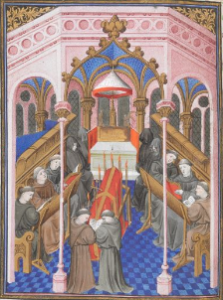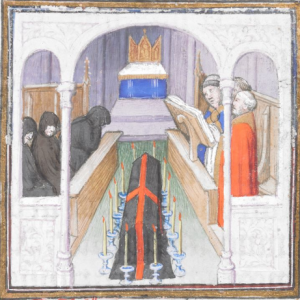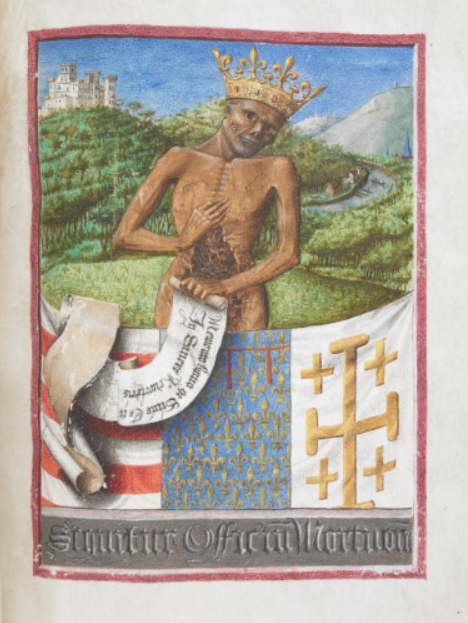One thing we can be certain of is that medieval society was absolutely obsessed with death. Be it the avoidance of purgatory, or a veneration of passed loved ones, the average medieval European lifestyle revolved around death. In the words of A. Galpern, “Catholicism at the end of the Middle Ages was in large part a cult of the living in the service of the dead” (Galpern 149). This obsession manifested itself in a multitude of ways, including the Office of the Dead, a component of medieval Books of Hours.

Essentially a collection of Ppsalms, prayers, and the stories of Job, the Office of the Dead acts as a means of reducing the purgatory sentence of departed loved ones through its their recitation. Typically at the back of Books of Hours, the Office of the Dead consists of three Hours:- Vespers, Matins, and Lauds, which were typically recited by paid monks during the process of funerals, and also (ideally) prayed daily at home (Wieck 117).
I am analyzing British Library, Egerton MS 1070, the Use of which is French. Uses, by the way, are just the general location where religious documents would have been used, and the documents tend to be the same between the same regions. Egerton MS 1070 oddly includes two Offices of the Dead, which I was unable to come across in my research. The typical one, complete with psalms and the story of Job, appears roughly mid-way through the manuscript, beginning on folio 55r and ending on 70v. There is nothing out of the ordinary here. Continuing further through the document, we come across a second Office of the Dead, this time spanning only three pages, from folio 117r-118r. To give a sense of scale, the short Office of the Dead contains 8 sections, while the long Office of the Dead contains 45 sections.

My goal here is to find the significance of having a short Office of the Dead when the long Office is already present. After attempting this research through multiple methods without bearing fruit, I realized that I might need to approach this manuscript differently. This led to my separating both Offices by section to see what the two Offices might have in common and what might have been cut from the longer Office.
One of the most noticeable things about the short Office of the Dead is that its content seems to be focused on the church service, particularly the requiem mass, which was a mass service devoted to the dead. I have come to this conclusion because the sections of the short Office that aren’t present in the Long Office ( Another interesting note is that the short Office of the Dead completely omits the anecdotes of Job, which are a central theme in the Office of the Dead. I think that the relation to Mass is key here in determining why these vast differences are present.
It appears to me that these two Offices were used in very different ways. As our class has learned, the reading and recitation of the Office of the Dead is typically a very personal thing that many tended to do on their own. In essence, the recitation of the long Office of the Dead tends to be a private affair that the medieval lay-person undertakes on their own, as often as they deem necessary to reduce their loved ones’ sentences in purgatory. The exception to this personal element of the Office of the Dead is shortly after the death of the loved one, in which a funeral mass would be recited by paid monks or clergy. After this however, it was the daily responsibility of the loved ones of the dead.
In contrast, the short Office of the Dead’s closer ties with the church service indicate that this Office would have been interacted with differently. This short Office would likely have been used as a guideline to the requiem mass. This begs the question– why was this Office included in the Egerton manuscript? I think it is entirely possible that the original owner of this manuscript, about whom we know depressingly little, would have wanted to follow along with the requiem mass. This would imply a certain level of literacy in the original owner of the manuscript, painting a bit more of a picture of who the owner was (although this pales in comparison to what we don’t know, which is almost everything else about them). In addition, we can assume the literacy of our original owner by the general lack of images. Egerton MS 1070 has far fewer painted miniatures than what I have seen in other manuscripts.
Upon comparison to a separate Requiem Mass found within Missale Romanum Mediolani, 1474, I have found that the Egerton MS 1070 Requiem Mass contains the same three necessary sections for a requiem mass: Oratio, Secreta, and Post Communion (483). Despite having the same components, each component differs majorly between the two documents, which is actually pretty typical for documents of different Uses. After doing some basic translation, I found that the Oratios, despite being very different in appearance and word choice, still serve the same general purpose– as a plea for God to protect the soul of the departed.
Unfortunately, Egerton MS 1070 reveals very little about its original owner. What we can take away from these two Offices of the Dead, however, is an idea of the type of devotion that the original owner of this manuscript held for both their faith and their family. Not to mention the crazy obsession with death! The short Office, being essentially the outline of a requiem mass, is much less extensive than the long Office of the Dead. This shows us how much time and energy they would have devoted to their religion and to the lessening of purgatory sentences; evidently, the original owner went to requiem mass frequently! That they would spend more time on a personal recitation for the dead than a mass service paints a clear picture of the level of devotion that the original owner would have held. Despite not getting any conclusive answers as to the necessity behind having two Offices of the Dead, I believe that the more significant differences between the two shows just how devoted our original owner was to their dearly departed. In addition, the Short Office of the Dead appears alongside many other “short” offices that would not have been standard for a document like this, which showcases just how passionate the original owner of Egerton MS 1070 was to their religion. I leave you, dear reader, with a miniature inserted in the manuscript by later owner, Rene D’Anjou:

Works Cited
- Wieck, Roger S. Painted Prayers: The Book of Hours in Medieval and Renaissance Art. 1997. ND3363.A1 W54 1997.
2. Galpern, A. “The Legacy of Late Medieval Religion in Sixteenth-Century Champagne.” The Pursuit of Holiness, edited by C. Trinkaus and H. A. Oberman, Brill Archive, 1974, p. 149.
